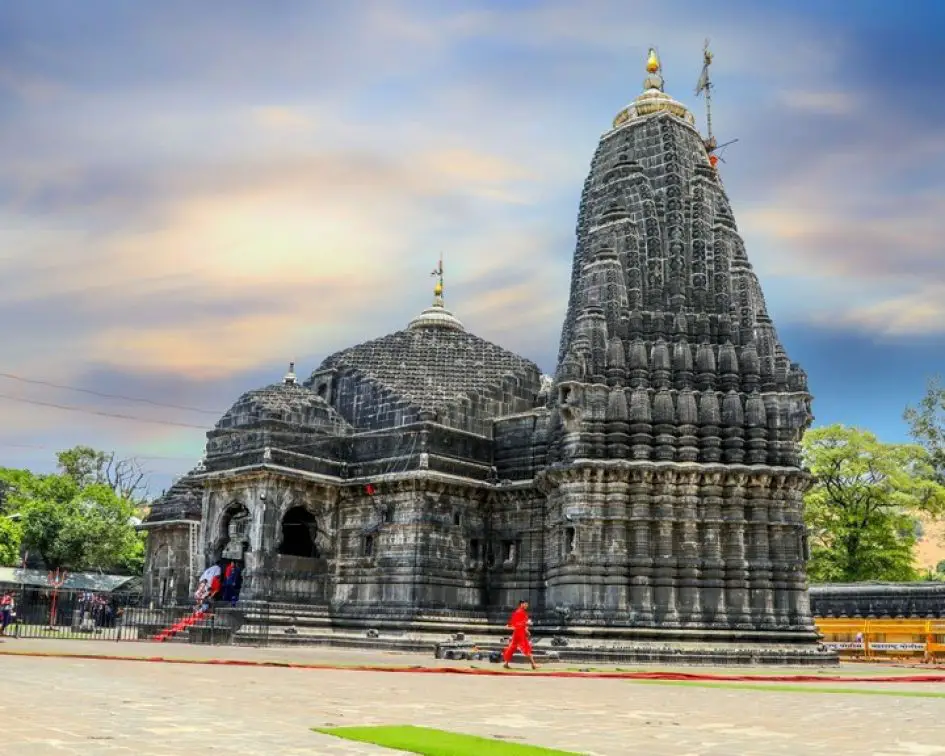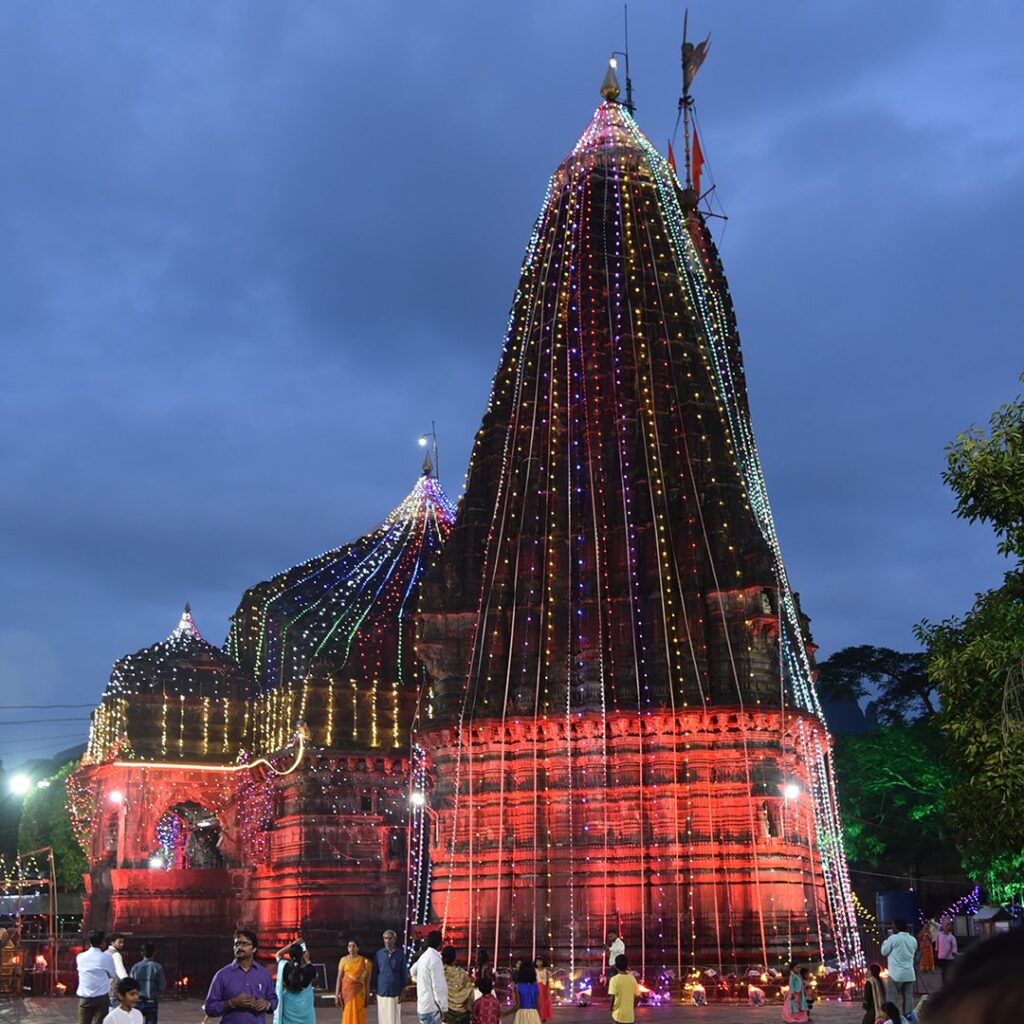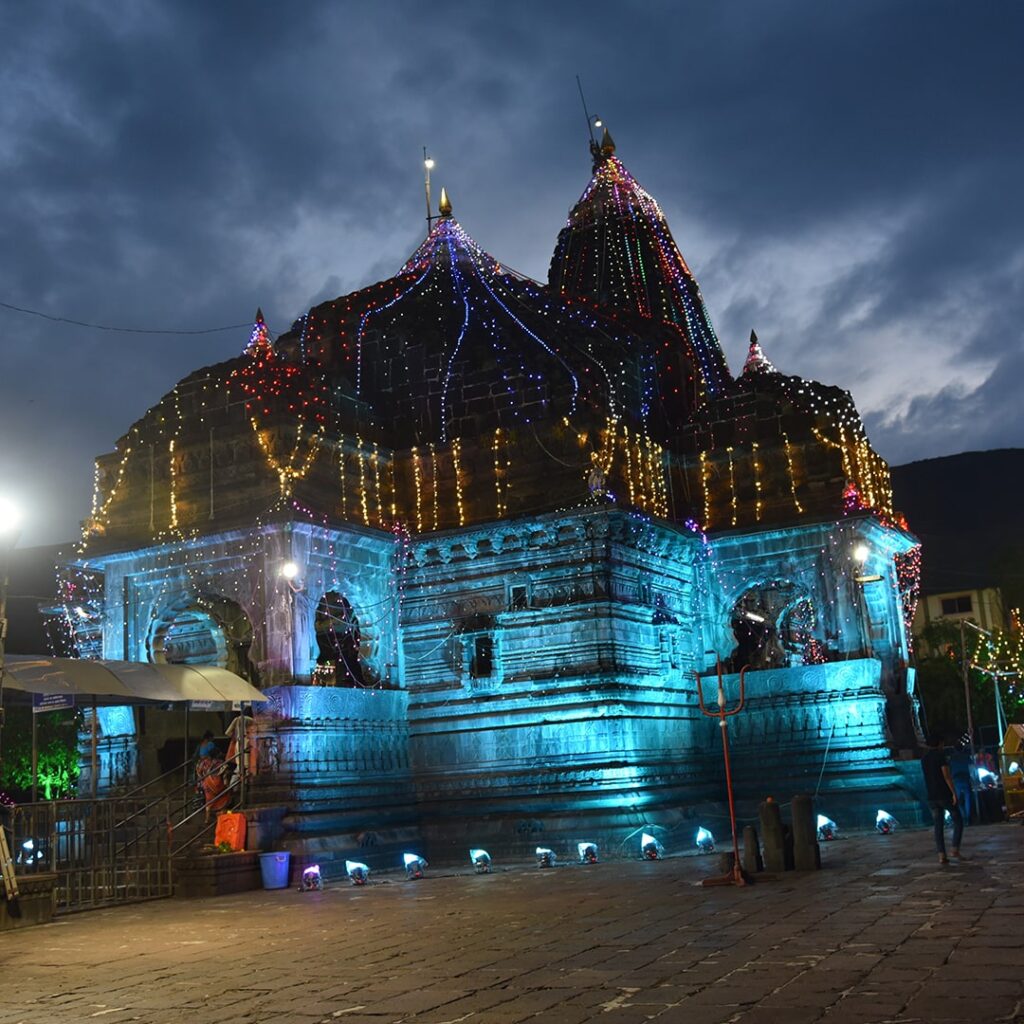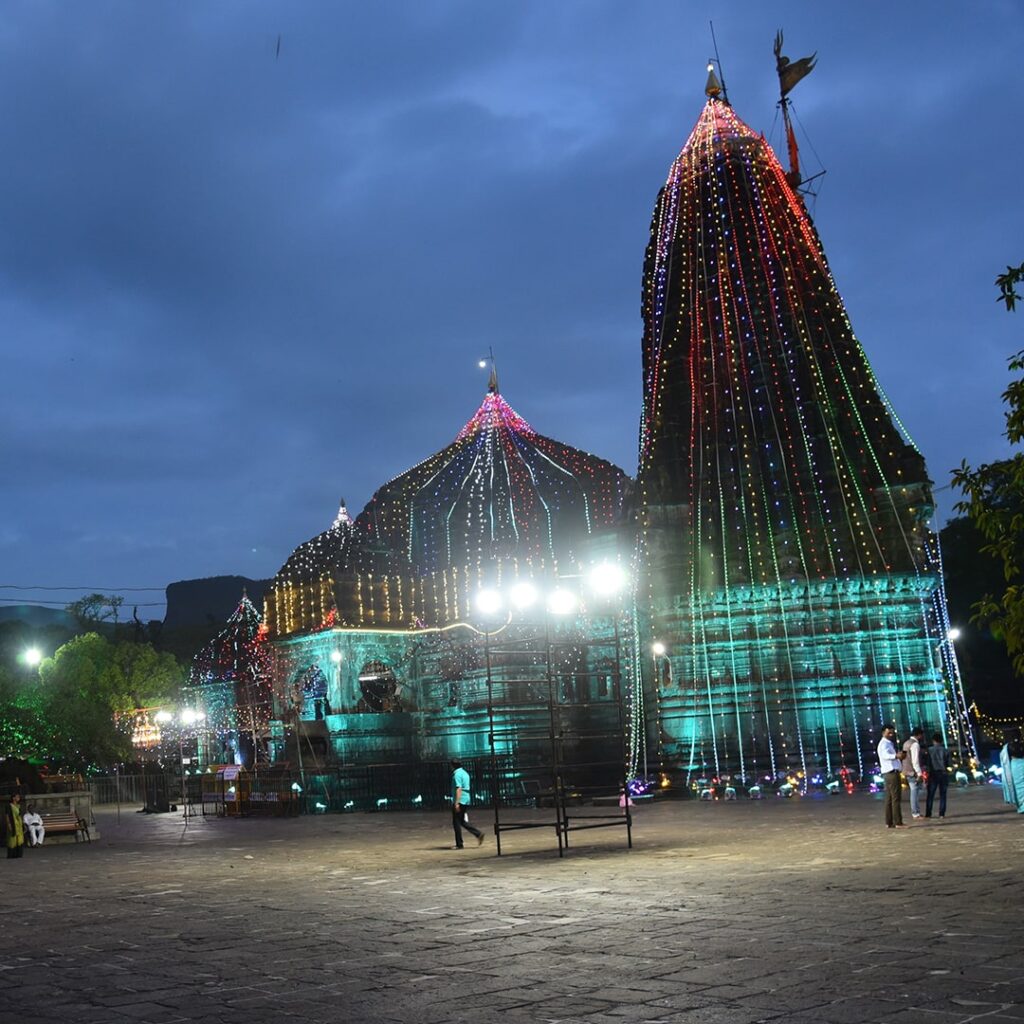“Trimbakeshwar Jyotirlinga Temple: A Journey to the Abode of Lord Shiva”
The Trimbakeshwar Jyotirlinga temple, located in the town of Trimbak in the Nashik district of Maharashtra, India, is one of the twelve Jyotirlingas in the country. It is a revered and sacred pilgrimage site for Hindus, and the temple is believed to be the abode of Lord Shiva. The temple is not just a place of religious significance but also boasts of scenic beauty that will leave you mesmerized. The picturesque surroundings, lush greenery, and serene atmosphere make it a perfect destination for a peaceful retreat.
If you are planning to visit this holy site, get ready to be captivated by the natural beauty of the region and indulge in the spiritual aura of the temple. In this blog, we will take you through everything you need to know about Trimbakeshwar Jyotirlinga temple – from its history, significance, and architecture to nearby places to visit and travel tips. So, sit back, relax, and get ready to embark on a spiritual and scenic journey to Trimbakeshwar Jyotirlinga temple.

Trimbakeshwar Jyotirlinga is one of the twelve Jyotirlingas or sacred abodes of Lord Shiva in India. It is located in the town of Trimbak in the Nashik district of Maharashtra state. The temple is situated at the foothills of the Brahmagiri Mountains, near the origin of the Godavari River. Trimbakeshwar Jyotirlinga is considered to be one of the most revered and ancient temples in India.
The origin of Trimbakeshwar Jyotirlinga dates back to ancient times. It is believed that the temple was built by the Pandavas during the Mahabharata era. According to Hindu mythology, the Godavari River originates from the Brahmagiri Mountains, and Lord Shiva himself resides in the form of Trimbakeshwar Jyotirlinga at the source of the river. The temple has undergone several renovations and restorations over the years, with the latest restoration work completed in 2015.
The architecture of Trimbakeshwar Jyotirlinga is a blend of the North Indian Nagara style and the South Indian Dravidian style. The temple is built of black stone and is adorned with intricate carvings and sculptures. The main shrine houses the lingam or the symbolic representation of Lord Shiva. The temple also has other shrines dedicated to Lord Vishnu, Lord Ganesh, and other deities.
One of the unique features of Trimbakeshwar Jyotirlinga is the presence of three lingams in the main shrine, representing Lord Brahma, Lord Vishnu, and Lord Shiva. It is believed that worshipping all three lingams together brings blessings and good fortune. The temple also has a sacred pool called the Kushavarta Kund, where devotees take a dip to cleanse themselves of their sins.


The temple has a rich history and cultural significance in Hinduism. Here are some measurements and dimensions of the temple –
- The temple complex covers an area of about 630,000 square feet.
- The temple is built in black stone and stands at a height of about 30 meters.
- The main shrine houses the lingam or the symbolic representation of Lord Shiva, which is about 3 feet tall and 2 feet in diameter.
- The temple has three lingams in the main shrine, representing Lord Brahma, Lord Vishnu, and Lord Shiva.
- The sacred pool called the Kushavarta Kund, located within the temple complex, is about 18 meters in diameter.
- The temple has a large courtyard or sabha mandap, which can accommodate thousands of devotees at a time.
- The temple’s entrance is adorned with intricate carvings and sculptures, and there are several other shrines dedicated to Lord Vishnu, Lord Ganesh, and other deities.
Trimbakeshwar Jyotirlinga is a popular pilgrimage site and attracts a large number of devotees from all over India. The temple is particularly crowded during the Mahashivratri festival, which is celebrated with great fervor and enthusiasm. The temple is also famous for its Kumbh Mela, which is held once every twelve years and attracts millions of devotees from all over the world.
Jyotirlingas are considered to be the most sacred abodes of Lord Shiva in Hinduism. There are twelve Jyotirlingas in India, each with its own mythological significance and historical importance. The word ‘Jyotirlinga’ is derived from the Sanskrit words ‘Jyoti’ meaning ‘radiance’ and ‘Linga’ meaning ‘symbol of Shiva’.


The twelve Jyotirlingas are located in different parts of India, and they are –
- Somnath Jyotirlinga in Gujarat
- Mallikarjuna Jyotirlinga in Andhra Pradesh
- Mahakaleshwar Jyotirlinga in Madhya Pradesh
- Omkareshwar Jyotirlinga in Madhya Pradesh
- Kedarnath Jyotirlinga in Uttarakhand
- Bhimashankar Jyotirlinga in Maharashtra
- Vishwanath Jyotirlinga in Uttar Pradesh
- Triambakeshwar Jyotirlinga in Maharashtra
- Vaidyanath Jyotirlinga in Jharkhand
- Nageshwar Jyotirlinga in Gujarat
- Rameshwaram Jyotirlinga in Tamil Nadu
- Grishneshwar Jyotirlinga in Maharashtra
Each Jyotirlinga has a unique mythological significance associated with it. According to Hindu mythology, Lord Shiva appeared in the form of a Jyotirlinga to eliminate the darkness and ignorance in the world. It is believed that by offering prayers and performing rituals at these Jyotirlingas, devotees can attain salvation and receive blessings from Lord Shiva.
The Jyotirlingas are not just places of religious significance but also architectural marvels. Each Jyotirlinga has its own distinct architectural style and design. Some of the Jyotirlingas have elaborate sculptures and carvings, while others have a more simplistic design.
The Jyotirlingas are also a popular destination for tourists and pilgrims alike. They attract millions of visitors every year from all over the world. The temples are often crowded during festivals and special occasions, such as Mahashivratri and Shravan month.
How to reach –
- By Air: The nearest airport is the Gandhinagar Airport in Nashik, which is about 40 kilometers away from the temple. From there, you can hire a taxi or take a bus to reach the temple.
- By Train: The nearest railway station is the Nashik Road railway station, which is well-connected to major cities in India. From there, you can hire a taxi or take a bus to reach the temple.
- By Road: Trimbakeshwar is well-connected by road to major cities in Maharashtra. You can take a bus or hire a taxi from Nashik or Mumbai to reach the temple. The Maharashtra State Road Transport Corporation (MSRTC) also operates regular bus services to Trimbakeshwar from Nashik.
Once you reach Trimbak, the temple is located in the heart of the town and can be easily reached by foot or by hiring a local taxi or auto-rickshaw



Here are some nearby places that you can visit for tourism –
- Anjaneri Hill: Anjaneri Hill is located about 8 kilometers from Trimbak and is believed to be the birthplace of Lord Hanuman. The hill offers beautiful views of the surrounding landscapes and is a popular trekking destination.
- Brahmagiri Hill: Brahmagiri Hill is located about 3 kilometers from Trimbak and is considered a holy place in Hinduism. The hill offers panoramic views of the surrounding valleys and is a popular pilgrimage site.
- Gangapur Dam: Gangapur Dam is located about 20 kilometers from Trimbak and is a popular tourist spot. The dam offers scenic views of the Godavari River and is a popular spot for picnics and boating.
- Sula Vineyards: Sula Vineyards, located about 30 kilometers from Trimbak, is one of the most famous wineries in India. The vineyard offers wine tasting tours, a restaurant, and a beautiful view of the surrounding vineyards.
- Nashik City: Nashik city, located about 30 kilometers from Trimbak, is a major tourist destination in Maharashtra. The city is famous for its ancient temples, beautiful landscapes, and vibrant culture.
In conclusion, a visit to the Trimbakeshwar Jyotirlinga temple is not just a pilgrimage but a spiritual journey that can leave you feeling rejuvenated and peaceful. From the breathtaking scenery to the sacred atmosphere, the temple offers a unique and fulfilling experience to every visitor. We hope that this blog has given you an insight into the history, significance, and beauty of the temple.
If you are interested in exploring more about travel, history, culture, and spirituality, we invite you to check out our other blogs. We cover a range of topics that can help you plan your next trip, gain knowledge, and find inspiration. Thank you for reading this blog, and we hope to see you soon again!
Looking for informative blogs on agriculture? Visit www.krushimantri.com for the latest news, updates, and insights on farming and agriculture.
If you’re a travel enthusiast, be sure to check out www.urbanchats.com for fascinating stories, travel guides, and tips to plan your next adventure.
Stay up-to-date on the latest trends, innovations, and news in the digital world by visiting Digital news. Your go-to source for all things digital.




3 Comments
Your comment is awaiting moderation.
id est architecto ut facilis voluptate libero nostrum voluptas. eius est nihil autem quia repudiandae accusamus placeat sint.
[…] Legend has it that the temple was built by Lord Rama during his exile and was later restored by the Peshwa rulers of the Maratha Empire. The temple is believed to be over 400 years old and is considered a significant pilgrimage site for devotees of Lord Shiva. […]
[…] Trimbakeshwar Temple Nashik is one of the most revered destinations when visiting Nashik as it is one of the twelve jyotirlinga sites. Lord Shiva is said to appear here as a pillar of light. The Holy Kumbh Mela of Nashik is held around this temple. Trimbakeshwar temple is attractive not only for its aura but also for its location between the three hills – Nilgiri, Brahmagiri, and Kalahari. […]
[…] Read In English Tech News […]